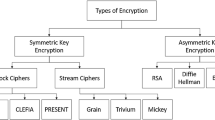Abstract
Pure position permutation image encryption algorithms, commonly used as image encryption investigated in this work are unfortunately frail under known-text attack. In view of the weakness of pure position permutation algorithm, we put forward an effective decryption algorithm for all pure-position permutation algorithms. First, a summary of the pure position permutation image encryption algorithms is given by introducing the concept of ergodic matrices. Then, by using probability theory and algebraic principles, the decryption probability of pure-position permutation algorithms is verified theoretically; and then, by defining the operation system of fuzzy ergodic matrices, we improve a specific decryption algorithm. Finally, some simulation results are shown.
Similar content being viewed by others
References
Bourbakis, N., Alexopoulos, C., 1992. Picture data encryption using SCAN patter.Pattern Recognit.,25(6): 567–581.
Ding, W., Qi, D.X., 1998. Digital image transformation and information hiding and disguising technology.Chinese Journal of Computer,21(9):838–843 (in Chinese).
Kuo, C.J., Chen, M.S., 1991. A New Signal Encryption Technique and its Attack Study. Proceedings of IEEE International Conference on Security Technology, Taipei, Taiwan,1:149–153.
Lin, T.Q., Klara, N., 1998. Camparison of MPEG encryption algorithms.Comput & Graphics 22(4):437–448.
Matlas, Y., Shamir, A., 1992. A video scrambling technique based on space filling curves.Proceedings of CPYPTO’87,76(5):550–559.
Refregier, P., Javidi, B., 1995. Optical-image encryption based on input plane and forier plane random encoding.Optics Letters,20(7):767–769.
Sridharan, S., Dawson, E., Goldburg, B. 1991. Fast Fourier transform based speech encryption system.IEE Proc. I, Commun. Speech Vis,138(3):215–223.
Yang, H.G., Kim, E.S., 1996. Practical image encryption scheme by real-valued data.Opt. Eng.,35(9):2473–2478.
Yen, J.C., Guo, J.I., 1999. A Chaotic Neural Network for Signal Encryption/Decryption and its VLSTI Architecture. Proceedings of the Tenth VLSI Design/CAD Symposium, Nantou, Taiwan, p.319–322.
Zhao, X.Y., Chen, G., 2002. Ergodic matrix in image encryption.SPIE, p.4875–4878.
Author information
Authors and Affiliations
Corresponding author
Additional information
Project supported by the National Natural Science Foundation of China (Nos. 60302012, 60202002) and the Youth Scientific Research Foundation of Ningbo (No. 2003A61006), China
Rights and permissions
About this article
Cite this article
Zhao, Xy., Cheng, G., Zhang, D. et al. Decryption of pure-position permutation algorithms. J. Zhejiang Univ. Sci. A 5, 803–809 (2004). https://doi.org/10.1631/jzus.2004.0803
Received:
Revised:
Published:
Issue Date:
DOI: https://doi.org/10.1631/jzus.2004.0803




